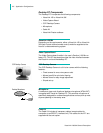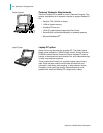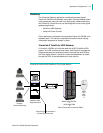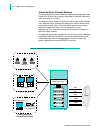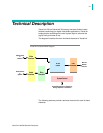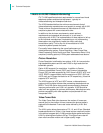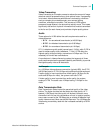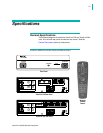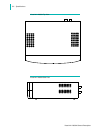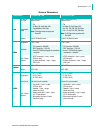
3-4 Technical Description
VisuaLink 128/384 General Description
...more on H.320 Videoconferencing
ITU-T H.320 specifies technical requirements for narrow-band visual
telephone systems and terminal equipment-- typically for
videoconferencing and videophone services.
The H.320 standard defines the minimum requirements that all
videoconferencing manufacturers must support to comply with H.320.
These minimum requirements ensure all manufacturer’s H.320
compliant systems will communicate with other.
In addition to the minimum requirements, certain optional
requirements and standards are also part of, or are used in
conjunction with H.320. The implementation of these options is left up
to the individual manufacturers. Implementing or not implementing
these options can significantly impact the video, audio and
transmission quality. This is why not all manufacturer’s H.320
compliant systems operate the same.
Five quality factors determine the overall performance of a
videoconferencing system: Picture Resolution, Video Frame Rate,
Video Processing, Audio Quality, and Data Transmission Rate. A fully
compliant (including options) H.320 system addresses these factors:
Picture Resolution
Picture Resolution is defined by two options: H.261 for low resolution
high bandwidth systems and the new H.263 for high resolution low
bandwidth systems.
Option H.263 supports five resolutions. In addition to Quarter
Common Intermediate Format (QCIF) and Common Intermediate
Format (CIF) that were supported by H.261 there is SQCIF, 4CIF, and
16CIF. SQCIF is approximately half the resolution of QCIF. 4CIF and
16CIF are 4 and 16 times the resolution of CIF respectively. (VisuaLink
supports QCIF and CIF).
The H.263 support of 4CIF and 16CIF means a videoconference
system could use higher bitrate video processing standards such as
MPEG. The H.263 option also corrects some processing flaws and
improves performance over H.261 only systems. H.263 should be
used in all new systems for optimum performance. Manufacturers who
provide compatibility with older systems and peripherals will also
incorporate H.261.
Video Frame Rate
The Video Frame Rate (also known as the number of frames per
second (fps)) is the number of times a second the picture image is
captured and refreshed. Frame rate is also defined by H.261 and
H.263.
The H.261 option allows frame rates of 7.5, 10, and 15 fps. (Standard
broadcast television is 30 fps). A low frame rate can cause any motion
in the picture to appear jerky. H.263 provides higher performance than
H.261 by allowing frame rates to 30 fps. This higher frame rate will
show much smoother motion and a higher quality image.



